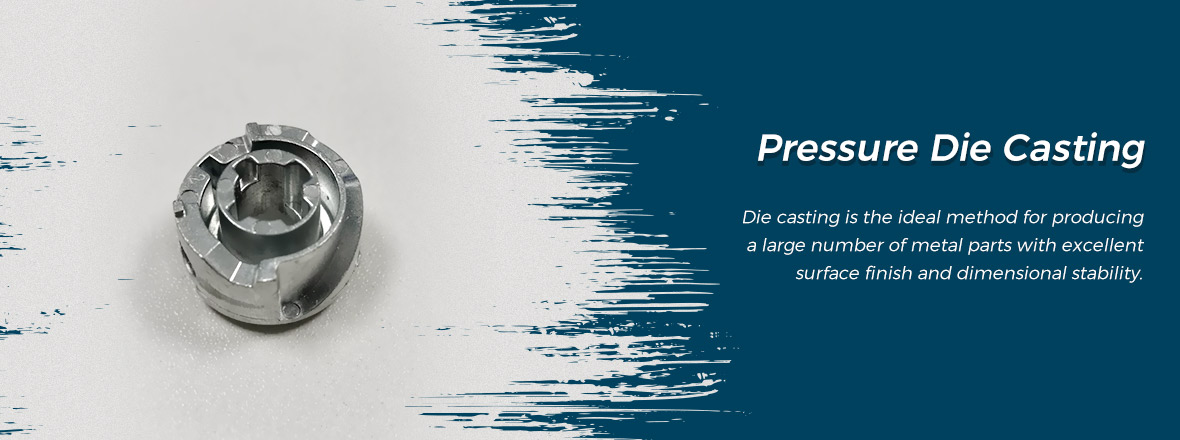Pressure Die Casting
Pressure die casting is a metal casting process. It is characterized by applying high pressure to the molten metal using the mold cavity. Molds are usually machined from stronger alloys, a process similar to injection molding. Most die castings are iron-free, such as zinc, copper, aluminum, magnesium, lead, tin, and lead-tin alloys and their alloys. Depending on the type of die casting, a cold chamber dies casting machine or a hot chamber die casting machine is required.
Pressure casting is a special casting method that has developed rapidly in modern metal processing technology with little or no cutting. It is the process of filling molten mold under high pressure and high speed and crystallizing and solidifying under high pressure to form castings. High pressure and high speed are the main features of pressure casting. The commonly used pressure is tens of MPa, the filling speed (in-gate speed) is about 16 to 80 m / s, and the time for filling the mold cavity with metal liquid is extremely short about 0.01 to 0.2 seconds.
Advantages of the pressure die casting
Die casting is the ideal method for producing a large number of metal parts with excellent surface finish and dimensional stability.
HPDC's production cycle includes:
1. Metering of metal into the shot sleeve.
2. Plunger movement.
3. Rapid die filling. The steel dies, typically 200-300°C, dissipates the latent heat.
4. During solidification, the casting is pressurized hydraulically by the plunger to feed the solidification shrinkage. Locking forces up to 4000 tons are commercially available to withstand the large pressures
5. The die is opened.
6. The casting is then ejected. The hydraulic energy is provided by a computerized system that permits control of metal position, velocity and plunger acceleration to optimize the flow and the pressure during filling and solidification.
Application of Pressure Die Casting
The number of parts varies from 50 or 100 of the prototype parts to thousands of mass production requirements-all of which will be produced in a careful and precise way that we apply to all projects.
- Automotive parts like wheels, blocks, cylinder heads, manifolds etc.
- Aerospace castings.
- Electric motor housings.
- Kitchen ware such as pressure cooker.
- Cabinets for the electronics industry.
- General hardware appliances, pump parts, plumbing parts.
Pajisjet e hedhjes së vdesit të Essai kanë aftësinë për të përpunuar forma të brendshëm dhe mund të prodhojnë forma me një peshë prej 2.5KGS dhe një madhësi deri në 500x500x250mm. Ne kemi 10 makina të hedhjes së vdesit me forca shtrënguese që variojnë nga 80T në 630T. Materialet e hedhjes që përdoren zakonisht janë alumini (zakonisht ADC10 / 12 dhe A380) dhe zinku (3 # / 5 #). Kallëpet gjithashtu mund t'i nënshtrohen një numri të madh të proceseve të dyta në objektet e përpunimit të vetë Essai, si dhe proceseve të ndryshme kozmetike duke përfshirë veshjen e pluhurit, veshjen me spërkatje, anodizimin, lustrimin dhe electroplating.
1. Derdhja e tubave me presion të lartë mund të ndahet në procese të "dhomës së ftohtë" dhe "dhomës së nxehtë".
2. Në procesin e dhomës së ftohtë, metali i shkrirë matet në një dhomë të ftohtë për çdo cikël makinerie (ose goditje).
3. Metali i shkrirë më pas detyrohet nga një kumëzxhi i vetëm përmes një kanali të ngushtë ushqyes (ose porte), në vetë zgavrën e vdesit, duke aplikuar presione nga 7 në 207 MPa.
4. Metali ngurtësohet shpejt sepse vdesin ftohet me ujë brenda një fraksioni të sekondës.
5. Pas ngurtësimit, vdesin hapen dhe hedhja hiqet duke përdorur kunjat e nxjerrësit.
6. Shumica e hedhjeve do të kenë flash aty ku të dy gjysmat e vdesin bashkohen. Kjo zakonisht hiqet në një gropë zvogëlimi.
7. Kostoja e lartë e karburanteve (deri në 250,000 £) dhe kostoja kapitale e makinerive (175,000 - 350,000) e kufizojnë këtë proces në prodhimin e vëllimit të lartë të përbërësve.
8. Derdhja e dhomës së nxehtë është e kufizuar në lidhjet e ulëta të magnezit dhe zinkut në pikën e shkrirjes, ku ndotja nga hekuri do të jetë më pak e gjerë. Një mëngë me shtiza është zhytur në një tenxhere të nxehtë të shkrirjes së shkrirë. Një kumëzxhi zbret dhe detyron metalin e shkrirë në gropë. Ndërsa pistoni tërhiqet, cilindri mbushet me metal.
1. High pressure dies casting is restricted to the lower melting point alloys.
2. The bulk of die casting is carried out in zinc-, magnesium- and aluminum-based alloys.
3. The most popular zinc-based alloys (known as Mazak) contain 3.8–4.3% aluminum and 0.10–1.25 wt% copper, with tensile strengths of 293–355 MPa, and elongations of 3–4%. Zinc alloys have a higher impact strength than die-cast aluminum alloys.
4. There is six main aluminum die casting alloys used in the UK. All contain 4–13 wt% silicon, which is used to promote good castability. The most common alloy is LM6-M (BS 1490), which contains 10–13% silicon, and has a tensile strength of 280 MPa and an elongation of 2–5%.
5. The strict melting practice is required with magnesium-based alloys, which are mainly used on hot-chamber machines. The most popular alloy contains 9–10% aluminum and 1% zinc, achieves a tensile strength of 215 MPa and an elongation of 2%.
6. The degree of retained porosity in the die casting affects the properties of the product.
Mirë se vini për të filluar biznesin tuaj tani!
Na kontaktoni




